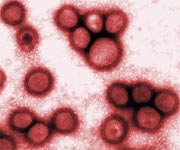 For the first time in medical history, scientists are set to reconstruct the Spanish flu virus—the “death virus” of 1918 that claimed millions of lives worldwide. This is not a science fiction story.
For the first time in medical history, scientists are set to reconstruct the Spanish flu virus—the “death virus” of 1918 that claimed millions of lives worldwide. This is not a science fiction story.
The aim of this thrilling project is to equip the scientific community with better knowledge to combat future global pandemics, starting from the current spread of avian influenza in Southeast Asia. The research team believes that their work will provide evidence that the 1918 flu pandemic originated from birds and offer a closer look at how it attacks and proliferates within the human body. Above all, this project marks a significant milestone in medical history, as it involves the reconstruction of a pathogen that caused one of the most devastating pandemics in human history.
Scientists assure that the re-emergence of the 1918 “death virus” does not pose a threat to the community. Approximately ten vials of the virus will be securely stored at the U.S. Centers for Disease Control and Prevention (CDC) in Atlanta, according to Terrence Tumpey, a member of the research team.
Similar to the 1918 virus, the current H5N1 avian flu strain in Southeast Asia also originates from birds. In 1918, a mutated flu virus infected humans and then spread from person to person. Meanwhile, the H5N1 virus currently in Asia has already infected and killed at least 65 people, but there are no signs of human-to-human transmission. However, the viral world is notorious for its rapid mutation capabilities, and thus H5N1 could soon develop infectious characteristics akin to the 1918 virus. Therefore, “the need to understand what happened in 1918 is urgent,” stated Dr. Jeffery Taubenberger, head of the gene sequencing team at the U.S. Army Institute of Infectious Disease Research.
The Spanish flu pandemic of 1918 spread globally within a few months and resulted in approximately 20-50 million deaths. In severe cases, victims experienced pleural effusion during the illness, which lasted less than a week. This strain of flu was particularly dangerous for young adults, a demographic typically less prone to pulmonary complications than the elderly. According to some experts, one reason the outbreak was exacerbated was due to malnutrition and poor living conditions in the aftermath of World War I.
One reason the research team believes that the recreation of the 1918 virus poses no threat is that modern pharmaceuticals can effectively treat the 1918 flu. Furthermore, today’s population has partial immunity to the disease. This is because a strain of the 1918 virus is relatively common, making it familiar to the human immune system, according to microbiologist Adolfo Garcia-Sastre from Mount Sinai School of Medicine.
In a study published in the journals Science and Nature, scientists explained how they recreated the 1918 virus: By using the remains of a woman who died from the flu and was buried in permafrost in Alaska in 1918, they constructed a genetic sequence of the virus. They shared this sequence with Dr. Garcia-Sastre and his colleagues at Mount Sinai, who would use this code to create a virus-like gene sequence called a plasmid. These plasmids were then sent to the CDC, where they were inserted into human kidney cells—the final step in the reconstruction process. “Once the plasmid is introduced into the human kidney cells, the virus will self-assemble,” Tumpey noted, “it only takes a few days” to accomplish this.
A typical flu virus consists of eight gene segments. Taubenberger and his team had previously published the sequences of five segments, and this new project will help them complete the remaining segments. The three new gene segments appear to be crucial in explaining how the virus adapts from birds to humans, Taubenberger asserted.
Tumpey also demonstrated the avian-friendly characteristics of the 1918 virus by introducing it into fertilized chicken eggs. The result was the destruction of these eggs, similar to what the H5N1 flu virus in Asia is currently doing. In contrast, modern flu strains from humans do not exhibit this behavior, he emphasized.
The research team is also focusing on a gene known as HA, which encodes the surface protein hemagglutinin, helping the virus attach to cells and replicate. According to Tumpey, the 1918 virus is dangerous due to this HA gene—once HA is removed, it becomes “milder.” Additionally, the genetic characteristics of the 1918 virus will help explain why it penetrates the lungs more deeply than current flu strains, causing pleural effusion.
Information about the gene sequences from the project is stored in GenBank, a public data repository managed by the National Institutes of Health. The gene sequences of the smallpox pathogen and other infectious diseases are also “stored” here.
Mỹ Linh (according to AFP, Nature)
















































